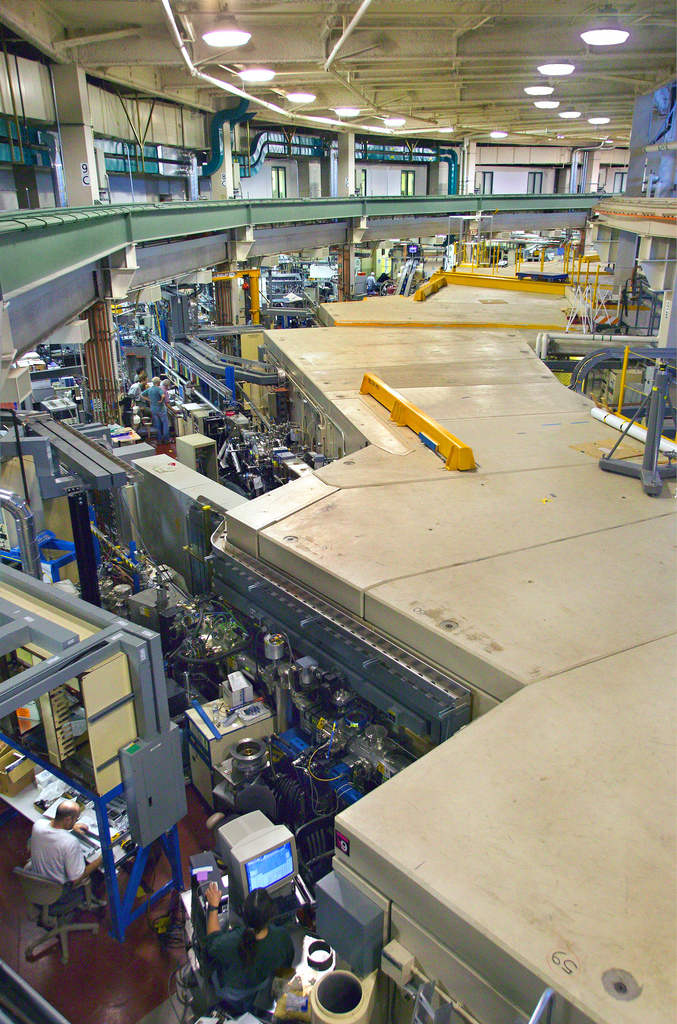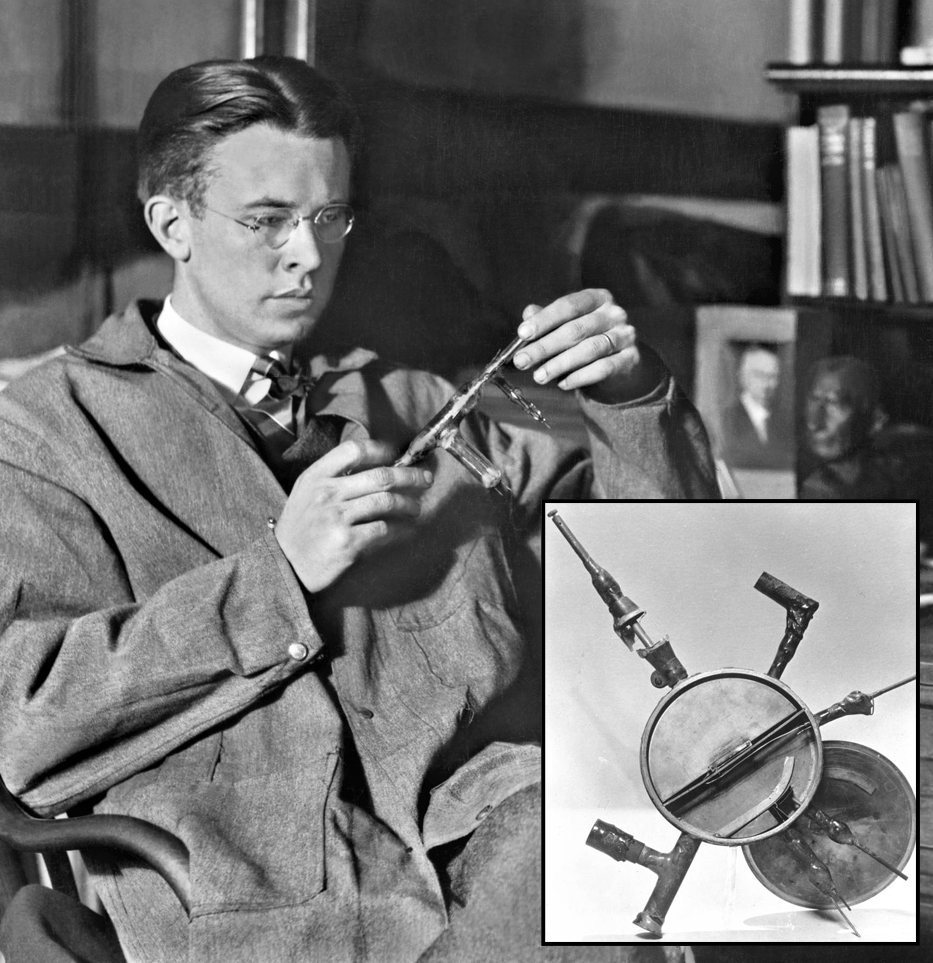Strange but true: the recently restarted Large Hadron Collider, the most powerful accelerator in the world, is the direct descendant of Thomas Edison’s light bulb. The light bulb was invented before electrons were discovered but nevertheless led to the first vacuum tubes, which for a long time were the principal means of accelerating and controlling charged particles in radios, medical x-rays, and other practical applications.
The late 1920s saw a burst of inventions intended for science. Cockroft and Walton’s voltage multiplier and Van de Graaff’s generator were powerful accelerators, but limited by the need to store an enormous electric charge. It was Rolf Widerøe’s design for a linear accelerator, or linac, enclosed in a segmented vacuum tube and designed to accelerate sodium and potassium ions (more massive and conveniently slower than electrons), that pointed Ernest Lawrence to a high-energy solution.
In effect, Lawrence wound Widerøe’s linear accelerator around and around itself to create the cyclotron, a machine that could boost a charged particle to very high energy by rhythmically switching the orientation of a relatively modest electric field. Almost overnight the word “accelerator” came to mean “atom smasher.”
Although vacuum-tube accelerators stayed around and continued to evolve for decades in radio, television, computer technology, and other fields, scientists who called themselves accelerator physicists pursued higher energies with mightier machines … until, one day, accelerators came to a fork in the road.
Enter the light source
When a charged particle is accelerated, jiggled in a light bulb’s hot filament or forced to turn a corner, for example, it loses energy in the form of light. This was a particular annoyance to designers of electron synchrotrons, who named the lost energy “synchrotron radiation.” (Protons and ions are so much more massive than electrons that the proportional loss of energy through synchrotron radiation, while significant, is less of an issue for the designers of these kinds of particle accelerators.)
It had already occurred to scientists that this light might be worth something for its own sake, but the first machine conceived and designed specifically for the production of synchrotron radiation didn’t come online until 1974. In a typical synchrotron light source, light comes from electrons moving through a simple bend magnet. The brightness is usually boosted by “insertion devices,” however — trains of dipole magnets called undulators or wigglers, whose poles alternate north and south to make the electrons slalom back and forth.
The resulting light – x-rays, ultraviolet, and a wide range of lower frequencies – continues along the straight path of the insertion devices and is taken off at a tangent to the storage ring through beamlines that end in experimental stations. Here the light can be used to resolve protein structures, investigate chemical reactions, and analyze the atomic-scale properties of materials, among many other investigations.
Light sources rapidly emerged as vital tools for scientific research. Within the light-source community, advanced accelerator methods have continually aimed at producing light that is brighter and comes in shorter pulses, and whose frequency, polarization, pulse length, repetition rate, and other variables are readily tunable.

Dozens of beamlines issue from the electron storage ring of the Advanced Light Source. For over fifteen years the ALS has been in the forefront of synchrotron light sources providing soft x-rays for a uniquely wide range of scientific endeavors.
Roger Falcone, director of Berkeley Lab’s Advanced Light Source (ALS) and the Lab’s associate director for photon sciences, remarks that “the ALS was built more than 15 years ago, but a few technical advances have brought our technology up to the level of the newest machines being built in Europe today.”
Progress has been so rapid, in fact, that synchrotron light sources are approaching the limits of what they can achieve in the way of short, bright pulses. For that reason, Falcone, John Corlett, and other creative scientists in the Lab’s ALS, Accelerator and Fusion Research (AFRD), and Engineering divisions are developing the technology for a new light source, of a kind known as a free electron x-ray laser.
Laser light from electrons
Like all lasers, a free electron laser (FEL) emits amplified coherent light, although the lasing medium is not a solid, liquid, or gas but rather the accelerated electrons themselves. In the technique called Self-Amplified Spontaneous Emission (SASE, pronounced “sassy”), emitted photons catch up and pass the electrons ahead of them in the beam, herding them into tight bunches. The undulator’s alternating magnets are spaced so that the photon wavelength and electron undulations are periodically matched in phase even though they are traveling at different speeds; thus each emission further amplifies the energy of the FEL light pulse, which can reach many orders of magnitude greater energy than that of a pulse from a synchrotron.
Another means of amplification is by “seeding” – shooting a separate laser beam through the electron beam to bunch the electrons, which then emit radiation at the seed laser frequency. Seeding produces light at a precise energy peak. If the bunches are sent through a second undulator, the emission can come from a “harmonic,” its frequency now two or three or more integer times the original seed laser frequency. Undulator pairs can be arranged in series so that each emits outgoing radiation at a harmonic of the incoming radiation, in a “seeded harmonic cascade.”
A number of FEL-based light sources are under construction or already in operation around the world, such as the Linac Coherent Light Source (LCLS) at the SLAC National Accelerator Center, the world’s first x-ray laser, and the soft x-ray Free-Electron Laser in Hamburg (FLASH) at Germany’s German Electron Synchrotron (DESY); FLASH is a pilot program for the hard-x-ray European XFEL scheduled to begin operation in 2014.
Meanwhile scientists in Berkeley Lab’s AFRD, ALS, and Engineering divisions are designing a unique new kind of light source that would outstrip the performance of any other soft x-ray FEL machine now in the works. At the heart of the Next Generation Light Source (NGLS) would be a superconducting linac operating in continuous-wave mode, allowing the repetition rate of electron bunches to be up to a million times greater, and beam power a thousand times greater, than existing linac-based light sources.
“The advantage as opposed to a synchrotron light source is that when electrons radiate coherently in a laser beam, you get about four orders of magnitude more electromagnetic power per electron,” Falcone says. “The downside is that, in a linear device, you usually get just one beam. So in thinking about a new generation machine, we plan to multiplex it.”
Synchrotrons, being roughly circular, can accommodate a great many beamlines, but a linac’s one-way electron beam can be switched between several undulators, each a FEL tailored for different experimental needs. The NGLS would feed up to 10 FELs, each of which could supply x-rays to two or more beamlines.
A SASE FEL might be optimized for brilliance, intensity, and the ability to provide a very large flux of photons with a high repetition rate – a hundred thousand times a second or more – but with relatively long x-ray pulses, each a leisurely few femtoseconds to 100 femtoseconds (100 quadrillionths of a second), for example. (This is still a very fine slice of time; there are as many femtoseconds in one second as there are seconds in 32 billion years.)
Another FEL might have less intensity but be capable of pulses a thousand times shorter, measured in mere attoseconds (quintillionths of a second) – with the ability to provide a pair of these ultrashort x-ray pulses at different wavelengths (“colors”) and controlled separation between the pulses, an important capability for x-ray pump-probe experiments.
Timing the pulses
The NGLS contemplates producing millions of electron bunches per second in a continuous and uniform stream. (Today’s best x-ray FELs are limited to 10 to 100-plus bunches per second.) The capacity for very high repetition rates ultimately resides in the injector and electron gun at the front end of the linac.
“You can’t improve the fundamental beam quality after the beam has been generated,” says John Corlett, who heads the Center for Beam Physics in AFRD. “So the performance of the whole machine depends on the quality of the beam generated by the injector and source – the electron gun.” Here the NGLS would outperform any existing or planned machine.
In the gun, a small, circular photoemission cathode gives off shaped bunches of electrons when hit by a pulse from a dedicated laser; the laser pulse rate determines the pulse rate of the electron bunches. The electrons are then accelerated by a strong, low-frequency electric field before entering the injector and the superconducting linac.
A prototype of the electron gun is being built for testing at a dedicated facility at the ALS. One challenge is to choose the right material for the photocathode, one that produces a high ratio of electrons to photons in a tight beam and holds up under continuous use at very high repetition rates, in a high accelerating field.

The components of a next-generation light source would include a high-repetition-rate electron gun, a continuous-wave superconducting linac, and a multitude of FELs, each tuned to optimize the experimenter's needs.
Timing and synchronizing the many components of an NGLS, including its photocathode laser, is a problem facing not just light-source designers but other accelerator designers as well. Widely separated components – up to a kilometer or more apart – must be synchronized to within femtoseconds, an interval in which light travels only a third of a millionth of a meter.
Berkeley Lab scientists lead in designing systems that use light frequency, not speed, to provide a master clock. Using a reference laser beam and an interferometer, the researchers count the number of light waves in the master-clock beam, which travels the length of the machine through an optical fiber. Any change in the length of the fiber changes the number of interference fringes per unit length.
“So we monitor the number of fringes and add or subtract length to maintain the right number,” says AFRD’s John Staples, who led the development of the synchronization system, which is already in place at Stanford’s LCLS.
Not only machine components but experiments maintain synchronization by means of the master clock. Pump-probe experiments can send in a laser pulse to excite a sample and follow with a probe pulse to see what happens after some precisely timed interval, which may be as little as a few hundred attoseconds.
The NGLS and the technology now being developed to build it – from electron guns to accelerator design to synchronization systems to multiplexed FELs – will not only open new frontiers of science but are scientific advances in themselves.
Continue reading Accelerators and Light Sources of Tomorrow, Part 2: Accelerating with Light
Additional information
More on the Advanced Light Source
Wikipedia’s article on Free Electron Lasers
More about seeded harmonics
More about the research underpinning a new soft x-ray light source and its components
More about Berkeley Lab’s unique high-repetition-rate electron gun
More about Berkeley Lab’s systems for synchronizing a new generation of accelerators
